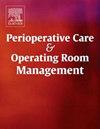Investigating the relationship between awareness, beliefs, and performance of operating room students in hand hygiene with analysis of microbial flora on hands during the COVID-19 pandemic
Q2 Nursing
Perioperative Care and Operating Room Management
Pub Date : 2024-12-01
DOI:10.1016/j.pcorm.2024.100430
引用次数: 0
Abstract
Background
Hand hygiene compliance among hospital staff has always been recognized as an effective method in controlling and reducing hospital-acquired infections. Since the outbreak of the COVID-19 pandemic, hand hygiene has emerged as one of the effective preventive measures against this disease, leading to increased awareness and concerns. This study aims to examine the awareness, beliefs, and practices of operating room students regarding hand hygiene, by analyzing the microbial flora on their hands during the COVID-19 pandemic. The objective is to assess the level of hand hygiene compliance among students, who will be future hospital employees.
Aim
This study aimed to investigate the correlation between the level of awareness, belief, and performance of operating room students regarding hand hygiene with the analysis of microbial hand flora during the COVID-19 pandemic. The purpose was to examine the compliance with hand hygiene among students, who will be future hospital employees, during this pandemic.
Methodology
The present study included a sample of 92 students majoring in Operating Room who were enrolled in the research through a census. The data collection tool consisted of a questionnaire to assess the students' awareness, beliefs, and performance regarding hand hygiene and analysis of microbial flora on hands. Standard culture media including Blood Agar, Brilliant Green Agar, and Eosin Methylene Blue were used for isolating microorganisms. Microorganism identification was performed using biochemical tests.
Results
The results of this study indicate that out of the participants, 65 were girls and 27 were boys with an average age of 21.9 ± 2.3 years. The mean scores for awareness, belief, and performance were 8.9, 72.3, and 64.2, respectively. Analysis of microbiological flora also revealed that the highest growth microorganisms were epidermidis bacteria (26.6 %), coagulase-negative staphylococci bacteria (22.9 %), and streptococcus bacteria (21.2 %).
Discussion and Conclusion
Based on the results of this study, operating room students have shown a high level of awareness, belief, and performance during the COVID-19 pandemic. Furthermore, the minimal growth of bacteria in the conducted culture samples confirms this finding. Due to the limited availability of studies, it is recommended that further research be conducted in this area.
求助全文
约1分钟内获得全文
求助全文
来源期刊

Perioperative Care and Operating Room Management
Nursing-Medical and Surgical Nursing
CiteScore
1.30
自引率
0.00%
发文量
52
审稿时长
56 days
期刊介绍:
The objective of this new online journal is to serve as a multidisciplinary, peer-reviewed source of information related to the administrative, economic, operational, safety, and quality aspects of the ambulatory and in-patient operating room and interventional procedural processes. The journal will provide high-quality information and research findings on operational and system-based approaches to ensure safe, coordinated, and high-value periprocedural care. With the current focus on value in health care it is essential that there is a venue for researchers to publish articles on quality improvement process initiatives, process flow modeling, information management, efficient design, cost improvement, use of novel technologies, and management.
 求助内容:
求助内容: 应助结果提醒方式:
应助结果提醒方式:


